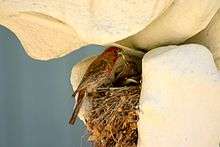Long Marine Laboratory
.jpg)
The Joseph M. Long Marine Laboratory is a research center located at the west edge of Santa Cruz, California. It is affiliated with the University of California, Santa Cruz and is a field base for researchers of the Monterey Bay. Long Marine Lab focuses primarily on marine sciences, and is the oceanside research center for UCSC's Institute of Marine Sciences (IMS).
Facilities at the lab include: The Center for Ocean Health, The Marine Wildlife Veterinary Care and Research Center, The National Marine Fisheries Service (NMFS), The Seabird/Raptor facility for the UCSC Predatory Bird Research Group, two large outdoor tanks for small marine mammals, four smaller pools with haulout areas for seals and sea lions, a three tank dolphinarium (acoustically engineered for the dolphin's sonar capabilities), and the Seymour Marine Discovery Center.
History
In many ways, the Monterey Bay presents an ideal place to study marine life for scientists and the general public alike. The development of an onshore marine laboratory had a high priority since the UCSC campus opened in 1965. The generous gift of land in 1972 by Mrs. Marion Stowell Younger and her late husband, Donald, made possible the development of the marine laboratory at the west edge of the city of Santa Cruz, less than a ten-minute drive from the UCSC campus. The 40-acre (160,000 m2) site contains a relatively undisturbed wetlands, the Younger Lagoon Reserve, and flat terraces for the marine lab buildings. Long Marine Lab opened in late 1978, and supports the marine research of the Santa Cruz faculty and students and is essential to the development of marine program of international recognition, which UCSC now has.
Seymour Marine Discovery Center
The Seymour Marine Discovery Center is the public outreach and marine education center located at Long Marine Lab. The building of the center was made possible by H. Boyd Seymour Jr., and opened March 11, 2000.
The Aquarium
The animals in the aquarium are all found in Monterey Bay, and give visitors a chance to get an up close look at the local biology of the area. The exhibits vary, but mainstays include several swell sharks, sea nettles, a California spiny lobster, and purple urchins. There are several areas where visitors are encouraged to touch local wildlife, including swell sharks, giant green anemones, bat stars, and giant kelp.

The Blue whale skeleton

"Ms. Blue" is the largest Blue whale skeleton displayed in the world. She washed ashore at Fiddlers Cove near Pescadero on September 6, 1979. Biologists and students from UC Santa Cruz began fleshing the whale, the whole process took about a month to complete. After being transported to UC Santa Cruz the carcass was buried near the college. In the summer of 1985, the bones were unearthed and reconstruction began. Frank Perry was hired to mount the cleaned bones for display. He and a group of specialists successfully constructed a steel framework to support the bones and recreate the proper arch of the spine and completed it in 1986. In 1999 the skeleton was finally moved to its final resting place at the Long Marine Laboratory. Ms. Blue is decorated with rope lighting during the month of December. The whale is 5.5 m (18 ft) tall and 26.5 m (87 ft) long. She was not fully grown when she died.
Marine Protected Area
Natural Bridges State Marine Reserve is a marine protected area off the coast of Long Marine Laboratory. Like an underwater park, this marine protected area helps conserve ocean wildlife and marine ecosystems.
Desalination plant
Due to the drought in Santa Cruz in the late 1970s the Soquel Creek Water District has agreed to split the bill with the city of Santa Cruz on a desalination plant. The city has not added to its water supply since that drought so the desalination plant would alleviate the threat of another drought. “Currently, work is being done to build a $4 million test desalination facility at the city's Long Marine Lab.” [1]
References
External links
- Seymour Marine Discovery Center
- About the Center: History
- Long Marine Laboratory
- Photographs of Joseph M. Long Marine Laboratorys from the UC Santa Cruz Library's Digital Collections
Coordinates: 36°56′56″N 122°03′54″W / 36.949°N 122.065°W
